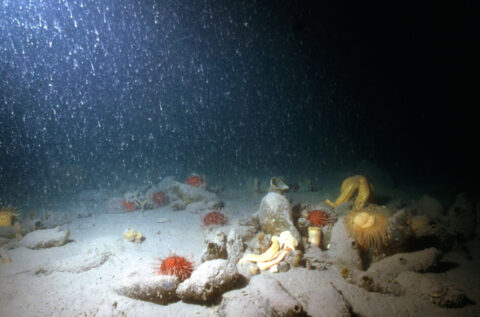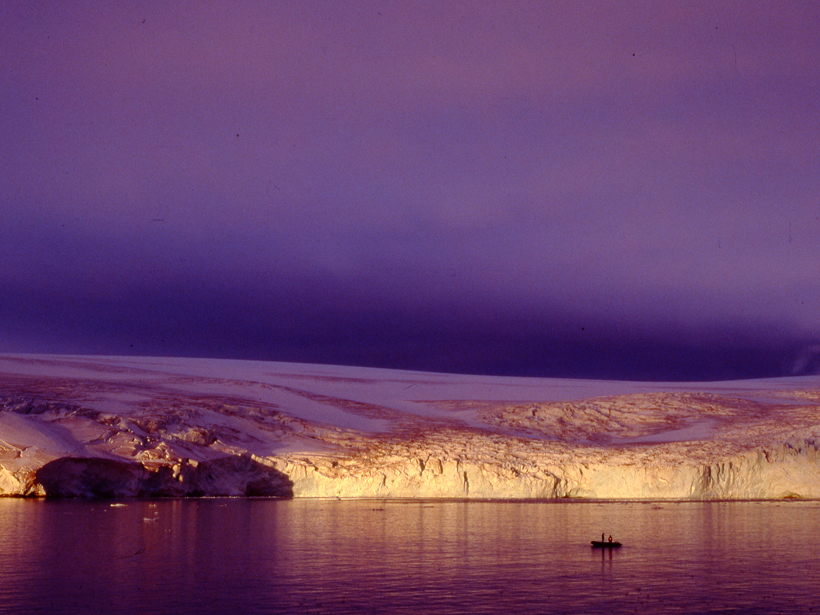As the changing climate causes Earth’s oceans to grow warmer and more acidic, the water in some regions is also becoming cloudier. When Antarctic glacial ice recedes, the meltwater trickles into surrounding fjords, carrying with it plenty of thawed sediment. New research suggests this sedimentation can cause chaos for marine organisms, known as benthos, that inhabit the deep water below.

The depths of Antarctic fjords may be frigid, but they are far from desolate. “You can equal [their] diversity to temperate or even some tropical systems,” says Ricardo Sahade, a researcher at the Instituto de Diversidad y Ecología Animal in Argentina. “It’s really amazing.” Sahade and his team observed the effects of sedimentation on one Antarctic benthic community over the course of 15 years, as reported in a study recently published in Science Advances.
Filter feeders, including sponges, quill-like pennatulids (sea pens), and sac-like ascidians (sea squirts), play a fundamental role in maintaining benthic ecosystems. They passively strain tiny organic particles and plankton from the water as it flows through their tissues. Highly effective as a natural sieve, a single sponge can filter 20,000 times its own volume in 24 hours. This sort of intense filtering prevents the water column from clouding out sunlight with particulate matter, which allows photosynthesizers like algae to thrive in the area studied. At the bottom of the food chain, these algae feed much of the rest of the community.
Glacial Retreat
The sharp increase in suspended fine-particle sediment with little organic content has complicated just about every aspect of life for filter feeders.
Potter Cove, where the team focused its research, has been hit hard by sedimentation changes in the past decade and a half—Sahade estimates that glaciers in the area have retreated at least 500 meters since the 1990s. The sharp increase in suspended fine-particle sediment with little organic content has complicated just about every aspect of life for filter feeders. With so much inorganic matter to filter, they expend more energy capturing the same quantity of food, and the suspended sediment can clog their respiratory systems.
When the team began its observations in 1994, benthic communities in the Potter Cove site closest to the glacier were teeming with filter feeders, Sahade and his colleagues reported in their 13 November study. At a depth of 30 meters (the maximum depth measured at the site), ascidians were by far the most dominant filter feeder, covering 28% of the seafloor. When the team returned in 1998, the population had plummeted, covering only 9% of the same region.
By the time the researchers returned in 2010, the ascidians’ ranks were still thin, but other organisms had made a miraculous recovery. Sea pens were far more abundant, and to the researchers’ great surprise, the sea sponge population soared. A closer look revealed that the nearby glacier had ceased its retreat long enough for some members of the community to recover. “But we don’t know what will happen with these new sponges there if the sediments increase again,” says Sahade. “We think this is a very unstable situation.”
Looking Deeper
Since Potter Cove is smaller and shallower than the average Antarctic fjord, there is still plenty of work to be done before scientists can determine the toll increased sedimentation may take. “Most of the fjord benthos is deeper, and most of the fjord bottom is around 500–700 meters along the Antarctic Peninsula, so the communities they’re working in are a little different than the ones that are typical of the fjords,” Craig Smith told Eos last week an hour before departing on a research voyage to Antarctica. Smith is a professor in the Department of Oceanography at the University of Hawai‘i at Mānoa.
Smith thinks sedimentation from glacial melt is having a greater impact on these benthic fjord communities than any other climate change stressor.
His team will be studying benthic communities in deeper fjords and comparing them to communities on the open shelf. Smith thinks sedimentation from glacial melt is having a greater impact on these benthic fjord communities than any other climate change stressor, but he believes that to truly understand the challenges they face, researchers must study these effects in tandem. “People typically study each of these stressors in isolation—sedimentation, acidification, warming temperature—but those stressors are synergistic,” he says. “Organisms have much greater difficulty dealing with a combination of them.”
—Shannon Kelleher, Writer Intern
Citation: Kelleher, S. (2015), Antarctic sediment plume disrupts deep-water community, Eos, 96, doi:10.1029/2015EO040597. Published on 1 December 2015.
Text © 2015. The authors. CC BY-NC 3.0
Except where otherwise noted, images are subject to copyright. Any reuse without express permission from the copyright owner is prohibited.

